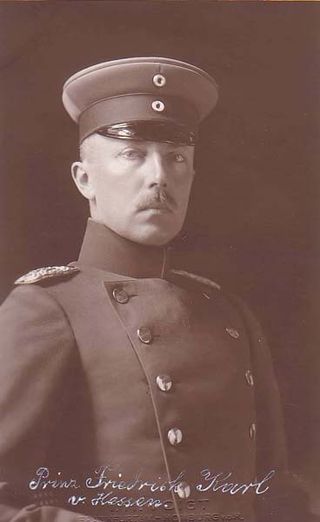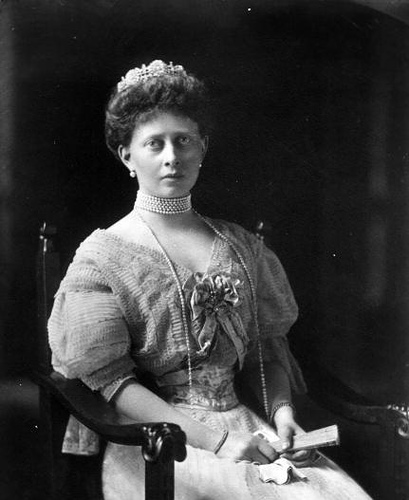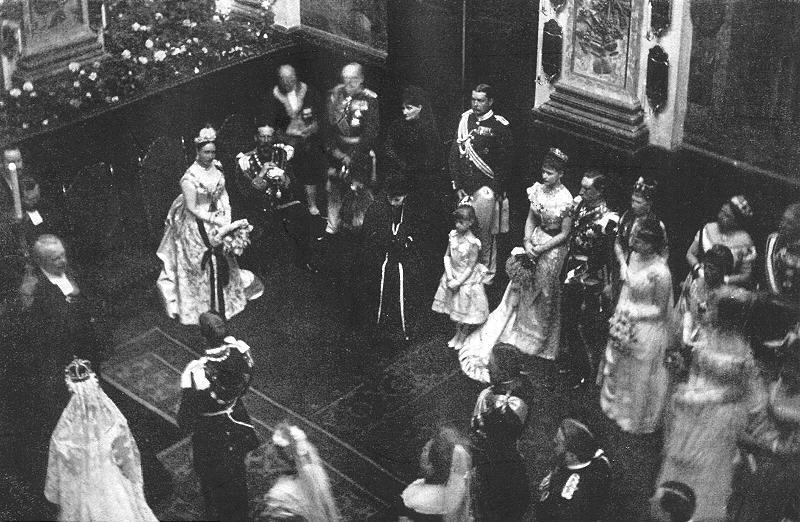by Susan Flantzer © Unofficial Royalty 2015

Louise, Queen of Denmark by unknown photographer, bromide postcard print, 1890s, NPG x74394 © National Portrait Gallery, London
Princess Louise of Hesse-Kassel (Luise Wilhelmine Friederike Caroline Auguste Julie), the wife of King Christian IX of Denmark, was born on September 7, 1817, in Kassel, Electorate of Hesse-Kassel, now in Hesse, Germany, where her father was stationed with the Danish army. Her father was Prince Wilhelm of Hesse-Kassel. Wilhelm’s father, Prince Friedrich of Hesse-Kassel, a grandson of King George II of Great Britain through his daughter Mary, was the founder of a cadet branch of the House of Hesse, Hesse-Kassel-Rumpenheim. In 1781, Friedrich bought Rumpenheim Castle in Offenbach, now in Hesse, Germany, from his brother Karl, and it became the family’s seat. It became a tradition to hold family reunions at Rumpenheim Castle. In the late 19th and early 20th centuries, many European monarchs were descendants of the Hesse-Kassel-Rumpenheim branch of the House of Hesse, and they continued the family reunion tradition.
Louise’s mother was a Danish princess, Princess Charlotte, the daughter of Frederik, Hereditary Prince of Denmark, the heir presumptive to the thrones of Denmark and Norway. He was the surviving son of King Frederick V of Denmark and his second wife, Juliana Maria of Braunschweig-Wolfenbüttel.
Louise lived in Denmark from the time she was three years old. The family first lived at the Prince Wilhelm Mansion in Copenhagen and later at the Brockdorff’s Palace, one of the four palaces of the Amalienborg in Copenhagen. Brockdorff’s Palace was later renamed Frederick VIII’s Palace and currently, it is the home of King Frederik X of Denmark and his family. Louise and her siblings received a typical royal upbringing. Louise was an accomplished painter and pianist. She received art lessons from two of the best Danish artists at the time, Martinus Rørbye and Wilhelm Marstrand, and was taught music by the composer Frederik Kuhlau.
Louise had five siblings:
- Karoline Friederike Marie of Hesse-Kassel (1811 – 1829)
- Marie Luise Charlotte of Hesse-Kassel (1814 – 1895), married Prince Frederick Augustus of Anhalt-Dessau, had issue including Adelaide of Anhalt-Dessau who married Adolphe, Grand Duke of Luxembourg
- Friedrich Wilhelm, Head of House of Hesse-Kassel (1820 – 1884), married (1) Grand Duchess Alexandra Nikolaievna of Russia, daughter of Nicholas I of Russia, died in childbirth, no issue; married (2) Princess Anna of Prussia, had issue including Prince Friedrich Karl of Hesse who married Princess Margaret of Prussia, daughter of Friedrich III, German Emperor and Victoria, Princess Royal
- Auguste of Hesse-Kassel (1823 – 1899), married Baron Carl Frederik von Blixen-Finecke, Lord of Näsbyholm, had issue
- Sophie Wilhelmine of Hesse-Kassel (January 1827 – December 1827)
The family had an important position in Denmark, and it became even more important when Princess Charlotte’s brother came to the Danish throne in 1839 as King Christian VIII. Not only was King Christian VIII Louise’s uncle, but he had only one legitimate child, the future King Frederik VII. Frederik had no children and Princess Charlotte was the only sibling of King Christian VIII to have children. This meant that it was likely that one of Princess Charlotte’s children would inherit the Danish throne.
On May 26, 1842, Louise married her second cousin Prince Christian of Schleswig-Holstein-Sonderburg-Glücksburg at Amalienborg Palace. Christian had visited Rumpenheim Castle in Hesse, where he took an interest in his future wife. After the wedding, the couple lived at the Yellow Palace in Copenhagen, Denmark.

Louise, Queen of Denmark; Christian IX, King of Denmark by François Deron, albumen carte-de-visite, early 1860s, NPG x74387 © National Portrait Gallery, London
Christian and Louise had six children:
- King Frederik VIII of Denmark (1843 – 1912), married Princess Louise of Sweden, had issue
- Princess Alexandra of Denmark (1844 – 1925), married King Edward VII of the United Kingdom, had issue
- Prince Vilhelm of Denmark, who became King George I of Greece (1845 – 1913), married Grand Duchess Olga Konstantinovna of Russia, had issue
- Princess Dagmar of Denmark, Maria Feodorovna after marriage (1847 – 1928), married Alexander III, Emperor of All Russia, had issue
- Princess Thyra of Denmark (1853 – 1933), married Crown Prince Ernest Augustus of Hanover, 3rd Duke of Cumberland and Teviotdale, had issue
- Prince Valdemar of Denmark (1858 – 1939), married Princess Marie of Orléans, had issue

Christian IX, King of Denmark and his family by Georg Emil Hansen, albumen carte-de-visite photomontage, 1862, NPG x74402 © National Portrait Gallery, London
Louise was as much the “Grandmother of Europe” as Queen Victoria was. Louise had 39 grandchildren and her grandsons included Nicholas II, Emperor of All Russia, King Constantine I of Greece, King George V of the United Kingdom, King Christian X of Denmark, and King Haakon VII of Norway. Louise is the ancestor of six of the ten current European monarchs (King Philippe of Belgium, King Frederik X of Denmark, Grand Duke Henri of Luxembourg, King Harald V of Norway, King Felipe VI of Spain, King Charles III of the United Kingdom) and two former monarchs (the late King Michael of Romania and the late King Constantine II of Greece).
- Children, Grandchildren, Great-Grandchildren and Notable Descendants of King Christian IX of Denmark

Painting (by Laurits Tuxex) of Christian and Louise with their large family of European royalty at Fredensborg Palace; Credit – Wikipedia
Like Louise, Christian spent much of his youth in Denmark and also had a claim on the Danish succession. Through his father, he was a direct male-line descendant of King Christian III of Denmark. Through his mother, Christian was a great-grandson of King Frederik V of Denmark. King Frederik VI of Denmark was the first cousin of Christian’s mother and was married to Christian’s maternal aunt Marie. King Christian VIII died in 1848 and was succeeded by his son King Frederik VII, who had married three times but had no children, resulting in a succession crisis. Women could inherit the Danish throne only if there were no male heirs (Semi-Salic Law), and Louise and her mother both rescinded their succession rights to Christian, Louise’s husband, in 1851. The Act of Succession of 1853 officially made Christian the heir of King Frederik VII, and he became king in 1863 when King Frederik VII died.
- Act of Acceptance and Assurance, July 15, 1851 (or how Christian became king)
- Royal Ordinance settling the Succession to the Crown on Prince Christian of Glücksburg
- Wikipedia: Royal descendants of Queen Victoria and King Christian IX
Louise preferred not to take a public role as Queen of Denmark. She focused on her children and grandchildren, and her charities. Louise relished her role as matriarch of an extensive European family and enjoyed the annual family reunions. She was the patron of 26 charities including: Kronprinsesse Louises praktiske Tjenestepigeskole (The Servant Girl’s School of Crown Princess Louise), Dronning Louises Børnehospital (Queen Louise’s Children’s Hospital), Louisestiftelsen (Louise Foundation), an orphanage for girls that trained them to be domestic servants, Diakonissestiftelsen (The Deaconess Foundation) which introduced the Deaconess profession in Denmark, Foreningen til Oprettelse af Friskolebørneasyler i Kbh.s Arbejderkvarter (Foundation for the Establishment of Charter School Asylums in the Labor Quarters of Copenhagen), and Belønnings- og Forsørgelsesforeningen (The Reward- and Self-Supporting Foundation) which supported domestic servants by providing financial aid to the ill, unemployed and retired.
Like her daughter Alexandra, Louise suffered from hereditary otosclerosis, abnormal growth of bone near the middle ear that can result in hearing loss. Louise’s deafness worsened during her last years and she was cared for by two deaconesses from the Deaconess Foundation she had started. Queen Louise, aged 81, died on September 29, 1898, at Bernstorff Palace near Copenhagen, Denmark, surrounded by a large part of her family, who had come to Denmark to be at her side. King Christian IX died at age 87 on January 29, 1906, at Amalienborg Palace in Copenhagen. Both were buried in the Glücksburger Chapel at Roskilde Cathedral in Roskilde, Denmark.
This article is the intellectual property of Unofficial Royalty and is NOT TO BE COPIED, EDITED, OR POSTED IN ANY FORM ON ANOTHER WEBSITE under any circumstances. It is permissible to use a link that directs to Unofficial Royalty.
Kingdom of Denmark Resources at Unofficial Royalty
- Kingdom of Denmark Index
- Danish Orders and Honours
- Danish Royal Burial Sites: House of Oldenburg, 1448 – 1863
- Danish Royal Burial Sites: House of Schleswig-Holstein-Sonderburg-Glücksburg, 1863 – present
- Danish Royal Christenings
- Danish Royal Dates
- Danish Royal Residences
- Danish Royal Weddings
- Line of Succession to the Danish Throne
- Profiles of the Danish Royal Family





























